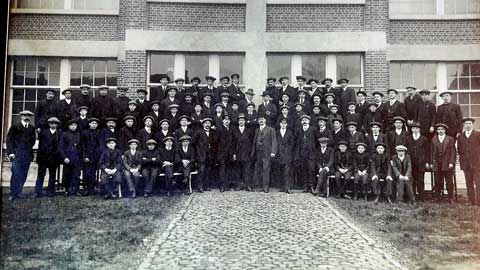Open-air spectacle ‘Diamant! ‘t Steentje van de Kempen’ takes you to a polisher family from Nijlen in the 1950s.
During the last weekend of September, Nijlen is under the spell of the open-air spectacle ‘Diamant! ‘t Steentje van de Kempen’. The Kerkplein is transformed into a typical Kempen village from the 1950s and the 150 actors and extras will take you back to the heyday of diamonds.
More than 3,000 visitors will be sucked into the story of a fictional family of diamond polishers from the 1950s. “The story starts in 2019 with an old diamond polisher musing about his youth. Then the audience is taken to the fifties, where the Van den Berg family tries to make a living by polishing diamonds. Father Van den Berg dies and mother is left behind with a mountain of debts and nine children. The apotheosis of the story takes place in 1958, not coincidentally the year of the World Expo in Brussels“, explains director Dirk Callens. “It will be a musical performance, but not a musical.” The director interviewed more than twenty polishers from this region. “From all these conversations, I was able to extract a lot of anecdotes that were interesting for the performance.”
This very local show is an opportunity for me to introduce you as a reader to the important role played by the Kempen in the history of the Belgian diamond industry.
How did the diamond industry develop in the Kempen region?
Modern diamond cutting with a cast iron turntable, diamond powder and oil was already discovered in 1456 by Bruggeling Lodewijk van Berken who polished the Florentiner for Charles the Bold. This was the beginning of the diamond industry in Bruges. In the 15th century, the centre of gravity of the diamond industry shifted to Antwerp. It was only at the end of the 19th century that the diamond trade in Antwerp became of great economic importance. Thanks to an increasing supply of rough diamonds (due to the discovery and exploitation of new mines) an entire diamond industry developed in a short period of time in Antwerp and the Kempen. Several municipalities such as Grobbendonk, Nijlen, Vorselaar … There were hundreds of polishing factories where a large part of the inhabitants worked.
The First World War temporarily halted the Belgian diamond industry, but the period 1918-1930 saw an enormous growth. At that time, diamonds were also processed in Diksmuide. The Second World War also caused a temporary interruption, after which the diamond polishing business continued to grow. In 1968 there were about 203 workshops in Nijlen. In almost every street of the municipality, family polishing companies were active.
In order to transform rough diamonds into precious stones, various operations have to be carried out. The skill of the diamond polisher is critical here, because only by exactly correct polishing the rough stone becomes a glittering diamond and as little as possible mass (carat) of the stone is lost. At the Stedelijk Lyceum in Antwerp there is a unique training in diamond processing in Flanders.
Both in Bruges and Antwerp, museums are dedicated to diamond processing. The diamond museum in Grobbendonk closed its doors in 2014. The diamond history of the Antwerp Kempen was investigated a few years ago in the regional heritage project ‘Schitterend geslepen‘. At the former Lieckens polishing factory in Nijlen, a new visitor centre for diamond processing opened in 2014. Various local museums also show the diamond worker’s tools.
This Kempens Diamond Centre in Nijlen has been open since the summer of 2014. It tells the story of the diamond industry in the Antwerp Kempen region. But the most important asset was the wait for the polishing factory itself to be restored.
Slijperij Lieckens aan de Spoorweglei is the last fully equipped pre-war diamond workshop in the region. The town council bought the unique factory and some adjoining land in 2004. But before anything could be done with it, a thorough restoration was urgently needed. The municipality of Nijlen and its partners have restored the installation and the building to its original glory. During the restoration an attempt was made to preserve the authenticity of the building as much as possible.
Due to the growing competition from low-wage countries, however, employment decreased. Today only a handful of diamond workers are active in the Kempen region. Antwerp, together with London, is still the most important centre in the world for diamonds.






